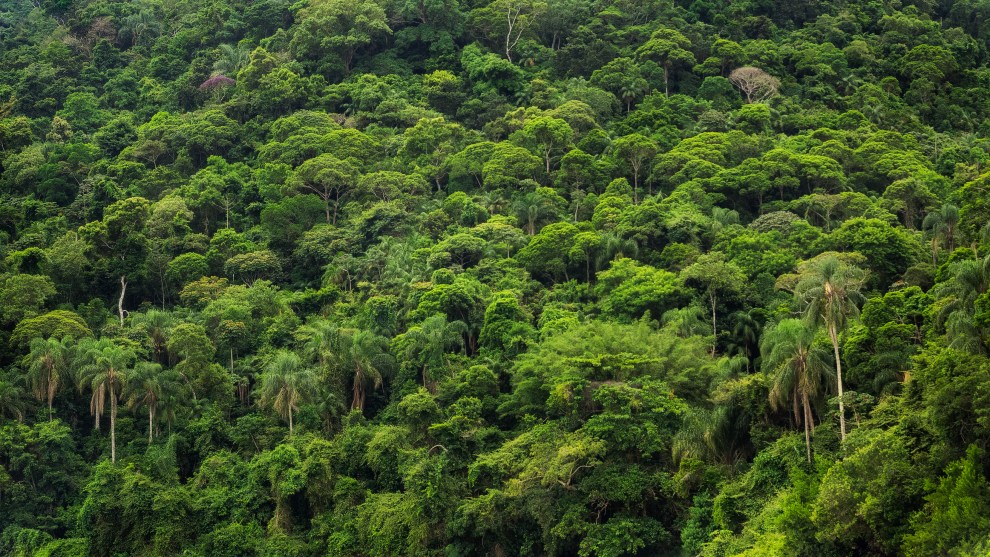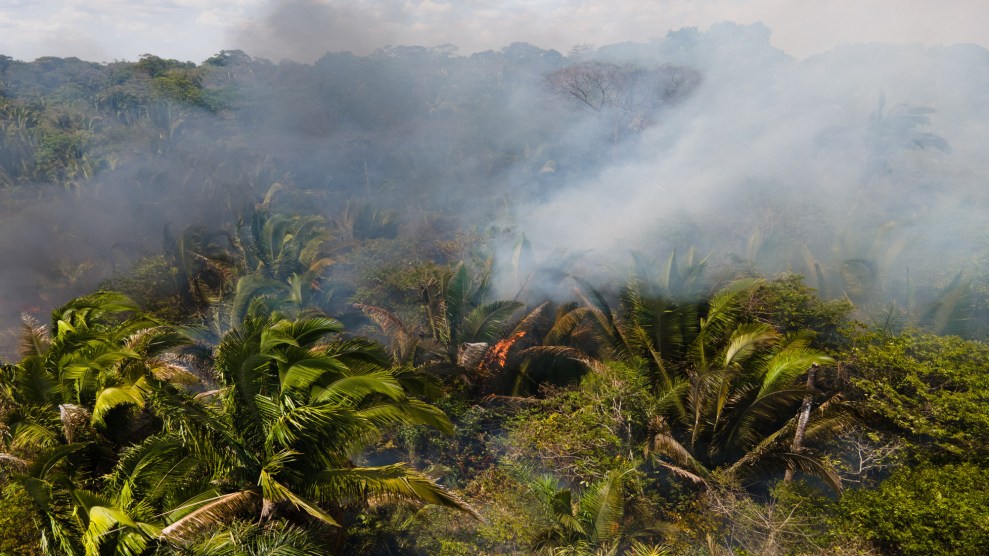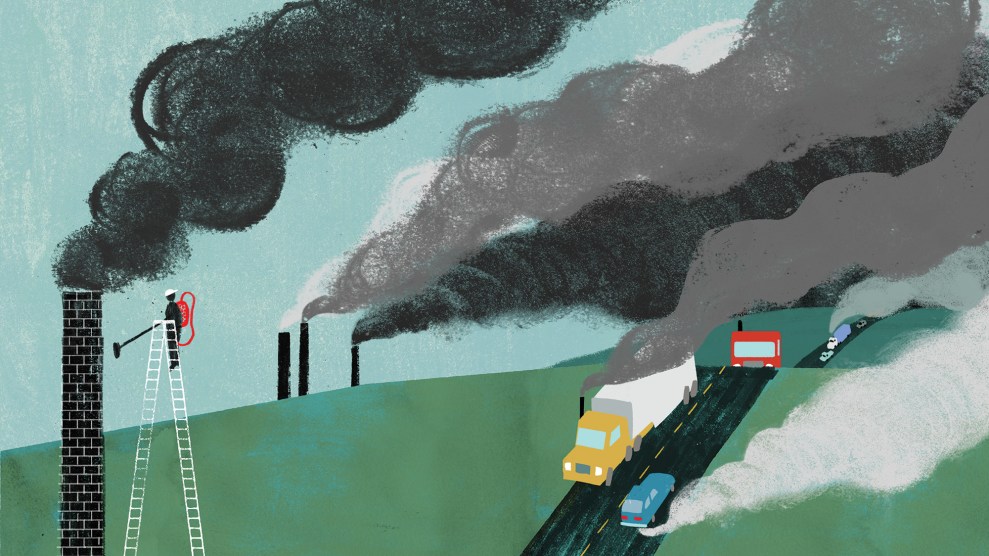
Dense, tropical rainforest in Brazil.R.M. Nunes / Getty
This story was originally published by the Guardian and is reproduced here as part of the Climate Desk collaboration.
The forest carbon offsets approved by the world’s leading provider and used by Disney, Shell, Gucci and other big corporations are largely worthless and could make global heating worse, according to a new investigation.
The research into Verra, the world’s leading carbon standard for the rapidly growing $2 billion voluntary offsets market, has found that, based on analysis of a significant percentage of the projects, more than 90 percent of their rainforest offset credits—among the most commonly used by companies—are likely to be “phantom credits” and do not represent genuine carbon reductions.
The analysis raises questions over the credits bought by a number of internationally renowned companies—some of them have labeled their products “carbon neutral,” or have told their consumers they can fly, buy new clothes, or eat certain foods without making the climate crisis worse. But doubts have been raised repeatedly over whether they are really effective.
The nine-month investigation has been undertaken by the Guardian, the German weekly Die Zeit and SourceMaterial, a nonprofit investigative journalism organization. It is based on new analysis of scientific studies of Verra’s rainforest schemes.
It has also drawn on dozens of interviews and on-the-ground reporting with scientists, industry insiders, and Indigenous communities. The findings—which have been strongly disputed by Verra—are likely to pose serious questions for companies that are depending on offsets as part of their net-zero strategies.
Verra, which is based in Washington, DC, operates a number of leading environmental standards for climate action and sustainable development, including its voluntary carbon standard (VCS) that has issued more than 1 billion carbon credits. It approves three-quarters of all voluntary offsets. Its rainforest protection program makes up 40 percent of the credits it approves and was launched before the Paris agreement with the aim of generating revenue for protecting ecosystems.
Verra argues that the conclusions reached by the studies are incorrect, and questions their methodology. And they point out that their work since 2009 has allowed billions of dollars to be channelled to the vital work of preserving forests.
The investigation found that:
- Only a handful of Verra’s rainforest projects showed evidence of deforestation reductions, according to two studies, with further analysis indicating that 94 percent of the credits had no benefit to the climate.
- The threat to forests had been overstated by about 400 percent on average for Verra projects, according to analysis of a 2022 University of Cambridge study.
- Gucci, Salesforce, BHP, Shell, easyJet, Leon, and the band Pearl Jam were among dozens of companies and organizations that have bought rainforest offsets approved by Verra for environmental claims.
- Human rights issues are a serious concern in at least one of the offsetting projects. The Guardian visited a flagship project in Peru, and was shown videos that residents said showed their homes being cut down with chainsaws and ropes by park guards and police. They spoke of forced evictions and tensions with park authorities.
To assess the credits, a team of journalists analyzed the findings of three scientific studies that used satellite images to check the results of a number of forest offsetting projects, known as Redd+ schemes. Although a number of studies have looked at offsets, these are the only three known to have attempted to apply rigorous scientific methods to measuring avoided deforestation.
The organizations that set up and run these projects produce their own forecasts of how much deforestation they will stop, using Verra’s rules. The predictions are assessed by a Verra-approved third party, and if accepted are then used to generate the credits that companies can buy and use to offset their own carbon emissions.
For example, if an organization estimates its project will stop 100 hectares (247 acres) of deforestation, it can use a Verra-approved formula to convert that into 40,000 CO2e (carbon dioxide equivalent) of saved carbon emissions in a dense tropical forest if no deforestation takes place, although the formula varies according to habitat and other factors. Those saved emissions can then be bought by a company and applied to its own carbon reduction targets.
Two different groups of scientists—one internationally based, the other from Cambridge in the UK—looked at a total of about two-thirds of 87 Verra-approved active projects. A number were left out by the researchers when they felt there was not enough information available to fairly assess them.
The two studies from the international group of researchers found just eight out of 29 Verra-approved projects where further analysis was possible showed evidence of meaningful deforestation reductions.
The journalists were able to do further analysis on those projects, comparing the estimates made by the offsetting projects with the results obtained by the scientists. The analysis indicated about 94 percent of the credits the projects produced should not have been approved.
Credits from 21 projects had no climate benefit, seven had between 98 percent and 52 percent fewer than claimed using Verra’s system, and one had 80 percent more impact, the investigation found.
Separately, the study by the University of Cambridge team of 40 Verra projects found that while a number had stopped some deforestation, the areas were extremely small. Just four projects were responsible for three-quarters of the total forest that was protected.
The journalists again analyzed these results more closely and found that, in 32 projects where it was possible to compare Verra’s claims with the study finding, baseline scenarios of forest loss appeared to be overstated by about 400 percent. Three projects in Madagascar have achieved excellent results and have a significant impact on the figures. If those projects are not included, the average inflation is about 950 percent.
The studies used different methods and time periods, looked at different ranges of projects, and the researchers said no modeling approach is ever perfect, acknowledging limitations in each study. However, the data showed broad agreement on the lack of effectiveness of the projects compared with the Verra-approved predictions.
Two of the studies have passed the peer review process and another has been released as a preprint.
However, Verra strongly disputed the studies’ conclusions about its rainforest projects and said the methods the scientists used cannot capture the true impact on the ground, which explains the difference between the credits it approves and the emission reductions estimated by scientists.
The carbon standard said its projects faced unique local threats that a standardized approach cannot measure, and it works with leading experts to continuously update its methodologies and make sure they reflect scientific consensus. It has shortened the time period in which projects must update the threats they face to better capture unforeseen drivers, such as the election of Jair Bolsonaro in Brazil. Verra said it already used some of the methods deployed by the researchers in its own standards, but does not believe they are appropriate for this project type.
Verra was specifically concerned with the use of “synthetic controls,” where the international group picked comparable areas and used them as a basis for deforestation measurements. Verra felt this was problematic because the controls might not reflect pre-project conditions, and also would compare the project with a hypothetical scenario rather than a “real area, as Verra does.” But the study authors argue that this mischaracterizes their work: The comparison areas used in both cases are real areas, with deforestation levels based on rates that are local to the projects. The Cambridge group does not use synthetic controls.
“I have worked as an auditor on these projects in the Brazilian Amazon and when I started this analysis, I wanted to know if we could trust their predictions about deforestation. The evidence from the analysis—not just the synthetic controls—suggests we cannot. I want this system to work to protect rainforests. For that to happen, we need to acknowledge the scale of problems with the current system,” said Thales West, a lead author on the studies by the international group.
Erin Sills, a co-author in the international group and a professor at North Carolina State University, said the findings were “disappointing and scary.” She was one of several researchers who said urgent changes were needed to finance rainforest conservation. “I’d like to find that conserving forests, which conserves biodiversity, and conserves local ecosystem services, also has a real effective impact on reducing climate change. If it doesn’t, it’s scary, because it’s a little bit less hope for reducing climate change.”
David Coomes, a professor of forest ecology at the University of Cambridge who was a senior author on a study looking at avoided deforestation in the first five years of 40 Verra schemes, was part of the Cambridge group of researchers. He reviewed the Guardian’s findings and said there was a big gap between the amount of deforestation his team estimated the projects were avoiding and what the carbon standard was approving.
“It’s safe to say there are strong discrepancies between what we’re calculating and what exists in their databases, and that is a matter for concern and further investigation. I think in the longer term, what we want is a consensus set of methods which are applied across all sites,” he said.
Julia Jones, a co-author and professor at Bangor University, said the world was at a crossroads when it came to protecting tropical forests and must urgently correct the system for measuring emission reductions if carbon markets are to be scaled up.
“It’s really not rocket science,” she said. “We are at an absolutely critical place for the future of tropical forests. If we don’t learn from the failures of the last decade or so, then there’s a very large risk that investors, private individuals, and others will move away from any kind of willingness to pay to avoid tropical deforestation and that would be a disaster.
“As someone who sits outside of the kind of cut and thrust of the wild west that is the carbon markets, I need to believe it can be made to work because money is needed to fund the emissions reductions from forest conservation.”
Yadvinder Singh Malhi, a professor of ecosystem science at the University of Oxford and a Jackson senior research fellow at Oriel College, Oxford, who was not involved in the study, said two of his PhD students had gone through the analysis without spotting any errors.
“This work highlights the main challenge with realizing climate change mitigation benefits from Redd+. The challenge isn’t around measuring carbon stocks; it’s about reliably forecasting the future, what would have happened in the absence of the Redd+ activity. And peering into the future is a dark and messy art in a world of complex societies, politics and economics. The report shows that these future forecasts have been overly pessimistic in terms of baseline deforestation rates, and hence have vastly overstated their Redd+ climate benefits. Many of these projects may have brought lots of benefits in terms of biodiversity conservation capacity and local communities, but the impacts on climate change on which they are premised are regrettably much weaker than hoped. I wish it were otherwise, but this report is pretty compelling.”
Shell told the Guardian that using credits was “in line with our philosophy of avoid, reduce and only then mitigate emissions.” Gucci, Pearl Jam, BHPm and Salesforce did not comment, while Lavazza said it bought credits that were certified by Verra, “a world’s leading certification organisation,” as part of the coffee products company’s “serious, concrete and diligent commitment to reduce” its carbon footprint. It plans to look more closely into the project.
The fast food chain Leon no longer buys carbon offsets from one of the projects in the studies, as part of its mission to maximize its positive impact. EasyJet has moved away from carbon offsetting to focus its net-zero work on projects such as “funding for the development of new zero-carbon emission aircraft technology.”
Barbara Haya, the director of the Berkeley Carbon Trading Project, has been researching carbon credits for 20 years, hoping to find a way to make the system function. She said: “The implications of this analysis are huge. Companies are using credits to make claims of reducing emissions when most of these credits don’t represent emissions reductions at all.”
“Rainforest protection credits are the most common type on the market at the moment. And it’s exploding, so these findings really matter,” she added. “But these problems are not just limited to this credit type. These problems exist with nearly every kind of credit.”
“One strategy to improve the market is to show what the problems are and really force the registries to tighten up their rules so that the market could be trusted. But I’m starting to give up on that. I started studying carbon offsets 20 years ago studying problems with protocols and programs. Here I am, 20 years later having the same conversation. We need an alternative process. The offset market is broken.”















